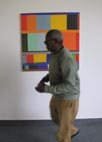Stanley Whitney
dal 13/10/2006 al 10/11/2006
Segnalato da
13/10/2006
Stanley Whitney
Esso Gallery, New York
All of Stanley Whitney's work takes off from the assumption that painting is a whole, complete and definite, a building to which he doesn't pretend to add anything. In a period in which it is easy to be an iconoclast, he distinguishes himself for the respect that he brings to painting.

"From one work to the other one, the painter continues to address only
one topic, which is neither communicative nor expressive, because it
doesn't claim to communicate something from the outside nor to express
something that he has inside, however he makes a coherent speech in
continuous development. The world of the painter is made only of
affirmative statements, of an apparent inner calm. Certainly, to get to
this point, the painter had to exclude a lot, but it's the only way to
keep the things of which he can be sure - and they are very few - and
to be able to look at them with confidence and attraction. At least for
a moment, because the painter's eye is always ironic and inquiring and
his quiet statements are not other than silent questions formulated
with discretion, after which there is nothing else to do but wait for
answers that possibly will never come and new questions that certainly
will."
"Who writes admires the painter's efforts to reach an absolute
impersonality, an autonomy of the work from the current conventions,
escaping the hated psychology, but starts to get irritated when he sees
the road toward impersonality brings the painter back again to the
self, being as well the Cartesian self, categorical, grammatical,
anonymous. But maybe this is the way to set the self free from the
stout heaviness of the personal autobiography. The painter creates his
own system of communication, a painting's inner code, a supporting
structure that the interpreter has to find and characterize, an unknown
foundation of rules that supports the organization and the composition
of his work."
"All of Stanley Whitney's work takes off from the assumption that
painting is a whole, complete and definite, a building to which he
doesn't pretend to add anything. In a period in which it is easy to be
an iconoclast, he distinguishes himself for the respect that he brings
to painting, for the loyalty to the painter's profession in it's more
humble elements, for the unpretentiousness, and, together with the
certainty in which he lines up new works in the very narrow edge that
remains of a creative activity reduced to the analysis of itself."
"The fact that his own work is not one but multiple worries the
painter, it obliges him to make new works that could contain the
previous ones, that could unify them and together would confirm them as
distinct. In the interval between one work and the next, time enters
the painter's work, time to which it is difficult to give a shape that
is not that of an autobiography. Each progressive work points out a
direction, a relationship of consequence and a pause of detachment in
the movement of the mind. His paintings, set one after the other,
become a story. They recount the story of the painter thinking and
making this work after the other one and before the next one. Later the
painter goes back to the canvas from where he started; the geometrical
squaring in a grid of colors; the picture that contains all pictures."
"Stanley Whitney's painting is the entirety at which nothing can be
added and at the same time the potentiality that implies everything
that can be painted."
Filippo Fossati, excerpted from Notes on Stanley Whitney's work, in 3
American Painters, Cabuttaldi Editore, Bossolasco Italy 2006
Saturday October 14, 6 p.m. - 8 p.m.
esso gallery
531 west 26th street - New York
Gallery hours: Tuesday through Saturday from 11 a.m. to 6 p.m.



